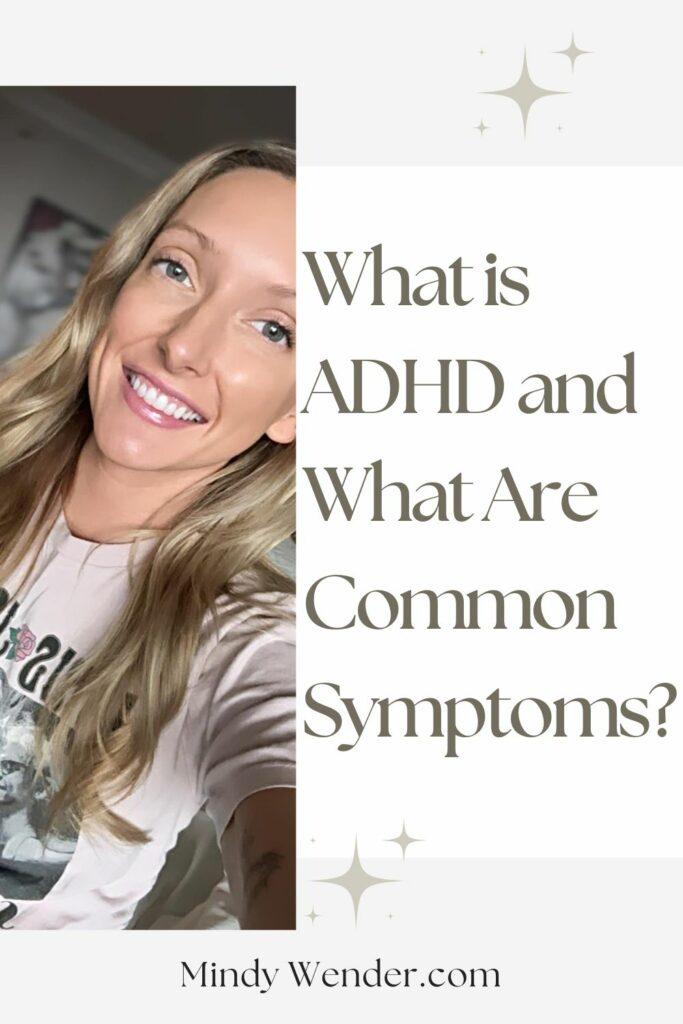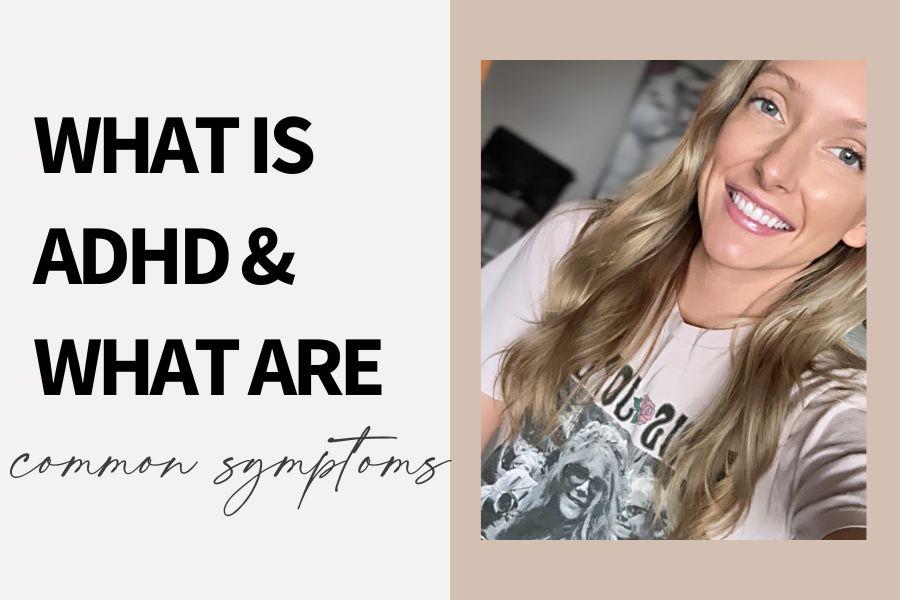I want to discuss a topic that’s super close to my heart – ADHD.
In this post, we’re diving deep into what ADHD is, my personal journey of going undiagnosed for 38 years, and six symptoms you might experience if you have ADHD.
Plus, we’ll explore the seven different types of ADHD. So, if you suspect you or a loved one might have ADHD, or if you’re already diagnosed, keep reading!
Pin It ✨

Before we dive into the details, I wanted to let you know that you can also listen to my podcast episode “Hyper Focused on ADD & ADHD (part 1) | What is it and common symptoms?” if you would rather listen! It’s perfect to listen to while getting ready, even if you’re driving a car.
You can listen below!

My Journey with ADHD
If you’ve been following me on social media, you know that my daughter Lilly has autism.
Our journey with her diagnosis has been a major learning curve, filled with a lot of research and discovery.
In 2017, we went to the Amen Clinic in California for a spec scan, and through this process, I started realizing more about my own brain. I began to wonder if maybe I wasn’t broken or stupid, but perhaps, like Lilly, I was on the spectrum.
Growing up, I wasn’t a great student. I wasn’t interested in school unless there was a clear reward, like not getting grounded so I could go to parties.
When I started my business 15 years ago, people around me doubted I’d stick with it because of my ADHD.
But if I’m obsessed with something, I go all in – hence the name of my podcast, Obsessed or Not Interested. That’s been the story of my life.
What is ADHD?
ADHD is not just one thing; it’s a cluster of symptoms.
It’s important to understand that ADHD isn’t a one-size-fits-all condition. There are actually seven different types of ADHD, each affecting different parts of the brain.
This means there are also multiple ways to manage and treat it. I got this information from Dr. Amen’s website, which has been an invaluable resource. Make sure to check it out!
Six Symptoms of ADHD
Here are six symptoms you might experience if you have ADHD:
- Short Attention Span: If you find it consistently hard to focus unless you’re really interested in something, this might be a sign.
- Easily Distracted: Background noise, movement, or even your own thoughts can easily pull your focus away.
- Sensitive to Environment: You might be more sensitive to sensory inputs like the feel of clothes, noises, or lights.
- Difficulty Organizing: Keeping things in order can be a real challenge. You might need systems in place to stay organized.
- Time Blindness: Losing track of time or underestimating how long tasks take is common. You might find it hard to be punctual.
- Impulsive Behavior: Blurting out thoughts or making hasty decisions can often happen without thinking them through.
Seven Types of ADHD
Understanding the different types of ADHD can help tailor treatment and coping strategies.
Each type involves different parts of the brain, which means there’s no one-size-fits-all approach to managing it. If you’re interested in learning more, I recommend checking out Dr. Amen’s work.
Here’s a brief overview of the seven types:
- Classic ADHD: This type includes symptoms of inattention, hyperactivity, and impulsivity. It’s what most people think of when they hear “ADHD.”
- Inattentive ADHD: Characterized by significant issues with attention and focus, but without the hyperactivity. Often missed because the symptoms are less disruptive.
- Over-Focused ADHD: Individuals with this type have trouble shifting attention and can get stuck in negative thought patterns. They might also have difficulty transitioning from one task to another.
- Temporal Lobe ADHD: This type includes symptoms of ADHD along with mood instability, aggression, and sometimes memory problems.
- Limbic ADHD: People with this type often experience chronic mild depression along with ADHD symptoms.
- Ring of Fire ADHD: This type involves extreme hyperactivity, sensitivity, and unpredictable behavior, often accompanied by mood disorders.
- Anxious ADHD: Combines ADHD symptoms with high levels of anxiety. These individuals are often tense, nervous, and may have physical symptoms like headaches and stomachaches.
Knowing which type of ADHD you or a loved one has can make a big difference in finding effective treatments. Different types respond to different therapies, medications, and lifestyle changes.
For a more in-depth look, I recommend checking out Dr. Amen’s work at the Amen Clinics, where they use brain imaging to help diagnose and treat ADHD.
Why Working Out is Important
Regular exercise is crucial for managing ADHD symptoms. It releases endorphins, improves mood, and helps regulate sleep patterns. Plus, it’s great for overall physical health, reducing the risk of chronic illnesses like heart disease and diabetes.
Here’s why getting moving can make such a big difference:
- Releases Endorphins: Exercise triggers the release of endorphins, which are natural mood lifters. This can help reduce feelings of anxiety and depression that often accompany ADHD.
- Improves Mood: Physical activity increases levels of serotonin and dopamine in the brain. These neurotransmitters play a key role in regulating mood and attention, which can help with the symptoms of ADHD.
- Regulates Sleep Patterns: Regular exercise can help regulate your sleep-wake cycle, making it easier to fall asleep and stay asleep. Good sleep is essential for managing ADHD symptoms.
- Boosts Physical Health: Exercise reduces the risk of chronic illnesses like heart disease, diabetes, and obesity. For someone with ADHD, staying physically healthy can also improve mental health.
- Provides Structure: Structured physical activity can provide a much-needed outlet for excess energy. It helps create routine and consistency, which are beneficial for managing ADHD.
- Enhances Focus: Physical activity can improve attention and concentration. Activities that require coordination and mindfulness, like yoga or martial arts, can be particularly beneficial.
For someone with ADHD, structured physical activity can provide a much-needed outlet for energy and help with focus.
My Personal Experience with Fitness
Fitness has been a game-changer for me. I used to think working out wasn’t for me until I discovered Turbo Jam, which was so fun and engaging.
This workout gave me hits of dopamine, which is exactly what my ADHD brain needed. This led me to get hyper-focused on health and fitness, and I eventually started my own business through Beachbody (now BODi).
If you’re looking for an effective and enjoyable way to work out at home, I highly recommend getting a BODi membership.
BODi offers a wide variety of workout programs that you can do from the comfort of your home.
Whether you’re into cardio, strength training, yoga, or dance workouts, there’s literally something for everyone. You can check out the membership options here.
Additionally, if you’re passionate about fitness and want to help others while earning an income, consider becoming a BODi partner like I did 15 years ago.
This opportunity has allowed me to turn my love for fitness into a rewarding career, helping others achieve their health goals while supporting my family. If you’re interested in joining the team, you can sign up here if you are ready, or learn more about joining my team here!
Starting my fitness journey with BODi has not only transformed my health but also provided me with a fulfilling career that I’m passionate about. If you’re ready to take the next step in your fitness journey, I encourage you to explore these opportunities.
Final Thoughts
ADHD can be challenging, but understanding it and finding effective ways to cope can turn it into a superpower.
Whether it’s through structured fitness routines, keeping a detailed planner, or simply understanding your brain better, there are ways to thrive with ADHD.
Thank you for reading! If you found this helpful, please share it with your friends.
For more tips, subscribe to my newsletter and connect with me on Instagram at @MindyWender or through my podcast page at Obsessed or Not Interested.
Feel free to shoot me a message if you have any questions!












